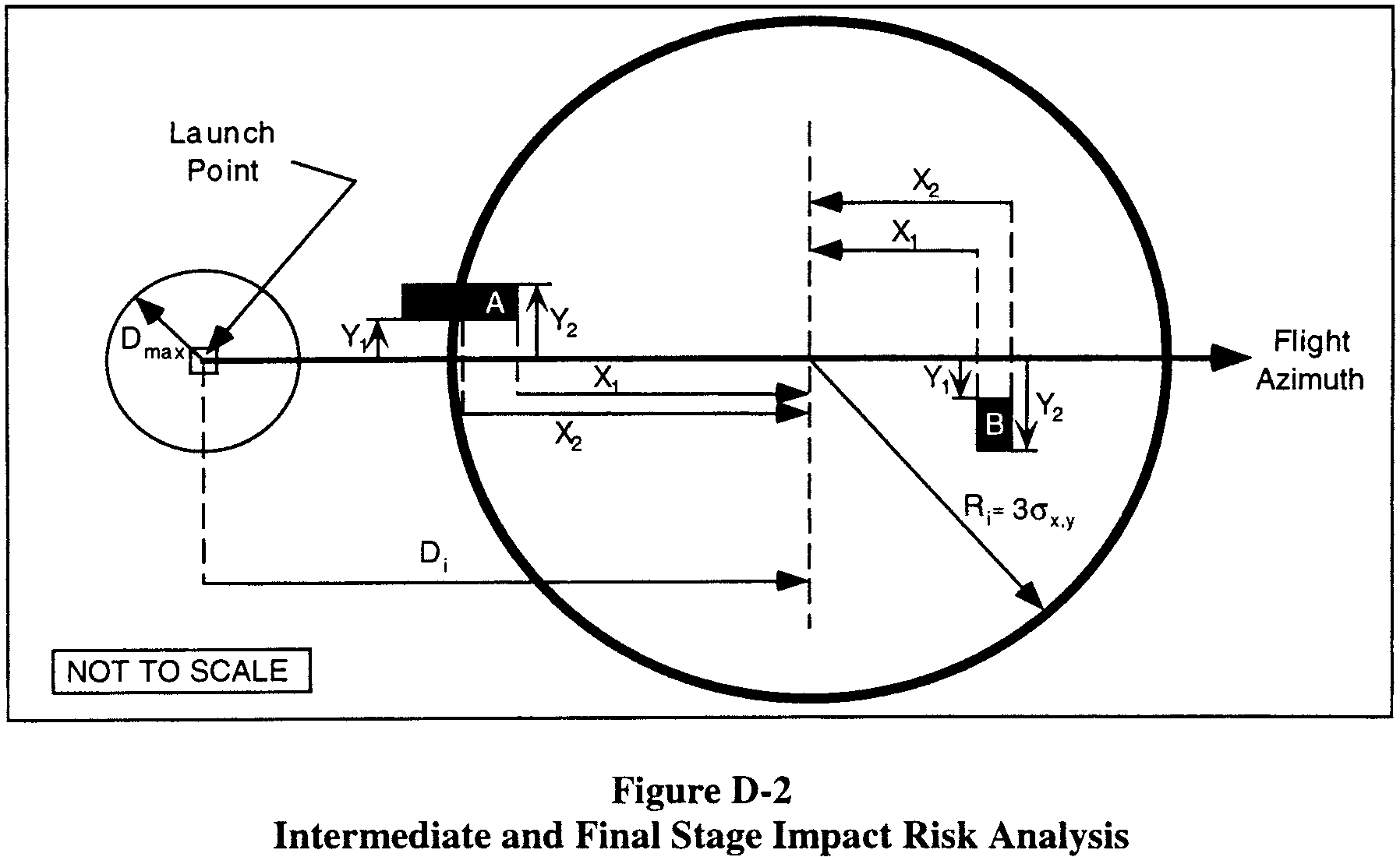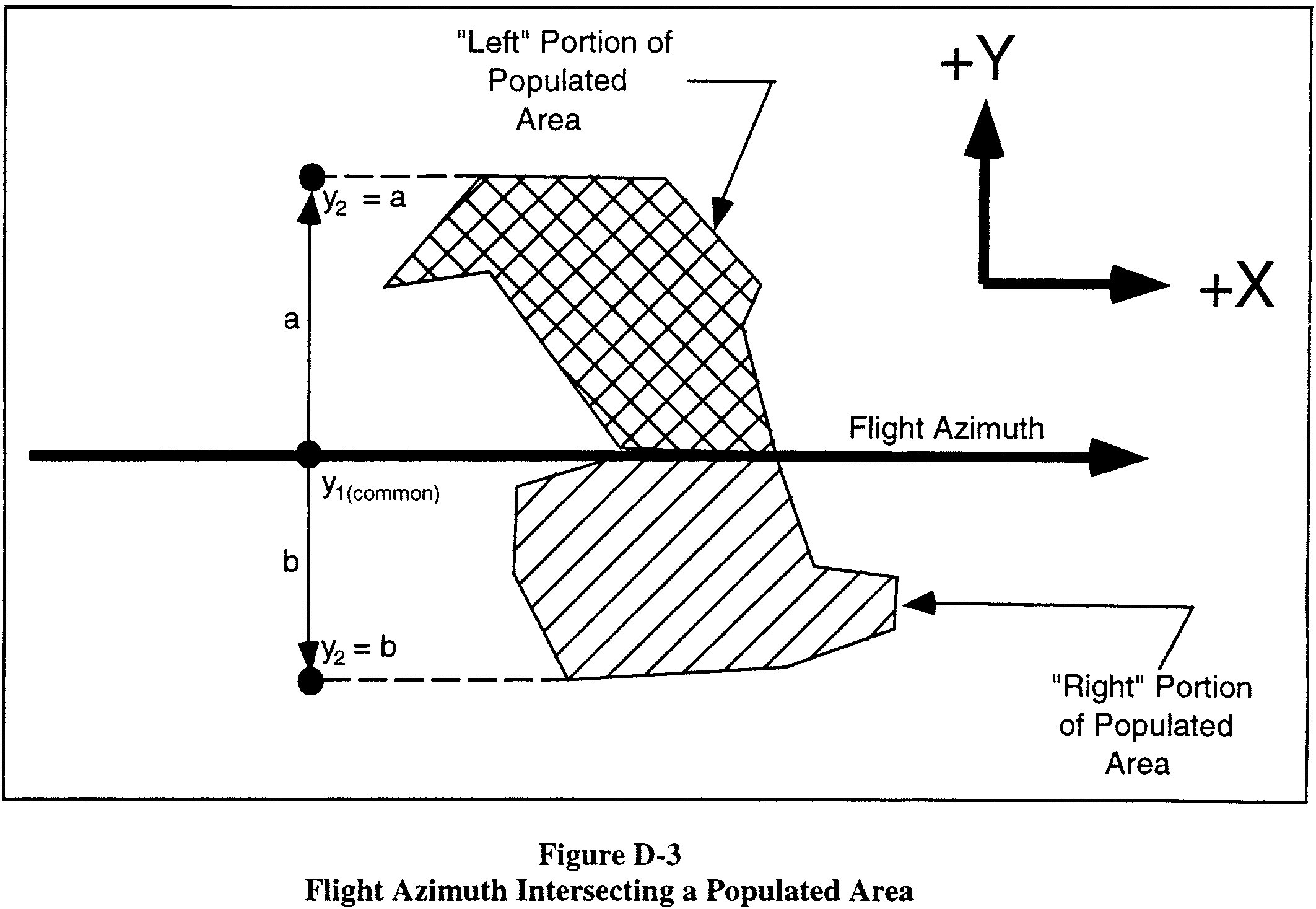Pt. 420, App. D
Appendix D to Part 420—Impact Dispersion Areas and Casualty Expectancy Estimate for an Unguided Suborbital Launch Vehicle
(a) Introduction
(1) This appendix provides a method for determining the acceptability of the location of a launch point from which an unguided suborbital launch vehicle would be launched. The appendix describes how to define an overflight exclusion zone and impact dispersion areas, and how to evaluate whether the public risk presented by the launch of an unguided suborbital launch vehicle remains at acceptable levels.
(2) An applicant shall base its analysis on an unguided suborbital launch vehicle whose final launch vehicle stage apogee represents the intended use of the launch point.
(3) An applicant shall use the apogee of each stage of an existing unguided suborbital launch vehicle with a final launch vehicle stage apogee equal to the one proposed, and calculate each impact range and dispersion area using the equations provided.
(4) This appendix also provides a method for performing an impact risk analysis that estimates the expected casualty (Ec) within each impact dispersion area. This appendix provides an applicant options to simplify the method where population at risk is minimal.
(5) If the estimated Ec is less than or equal to 1 × 10−4, the FAA will approve the launch point for unguided suborbital launch vehicles. If the estimated Ec exceeds 1 × 10−4, the proposed launch point will fail the launch site location review.
(b) Data Requirements
(1) An applicant shall employ the apogee of each stage of an existing unguided suborbital launch vehicle whose final stage apogee represents the maximum altitude to be reached by unguided suborbital launch vehicles launched from the launch point. The apogee shall be obtained from one or more actual flights of an unguided suborbital launch vehicle launched at an 84 degree elevation.
(2) An applicant shall satisfy the map and plotting data requirements of appendix A, paragraph (b).
(3) Population data. An applicant shall use total population (N) and the total landmass area within a populated area (A) for all populated areas within an impact dispersion area. Population data up to and including 100 nm from the launch point are required at the U.S. census block group level. Population data downrange from 100 nm are required at no greater than 1° × 1° latitude/longitude grid coordinates.
(c) Overflight Exclusion Zone and Impact Dispersion Areas
(1) An applicant shall choose a flight azimuth from a launch point.
(2) An applicant shall define an overflight exclusion zone as a circle with a radius of 1600 feet centered on the launch point.
(3) An applicant shall define an impact dispersion area for each stage of the suborbital launch vehicle chosen in accordance with subparagraph (b)(1) in accordance with the following:
(i) An applicant shall calculate the impact range for the final launch vehicle stage (Dn). An applicant shall set Dn equal to the last stage apogee altitude (Hn) multiplied by an impact range factor [IP(Hn)] in accordance with the following:
![Equation for (i) An applicant shall calculate the impact range for the final launch vehicle stage (Dn). An applicant shall set Dn equal to the last stage apogee altitude (Hn) multiplied by an impact range factor [IP(Hn)] in accordance with the following](https://aviation-regulations.com/img/graphics/er19oc00.111.jpg)
where:
IP(Hn) = 0.4 for an apogee less than 100 km, and
IP(Hn) = 0.7 for an apogee of 100 km or greater.
(ii) An applicant shall calculate the impact range for each intermediate stage (Di), where i ε {1, 2, 3, . . . (n− 1)}, and where n is the total number of launch vehicle stages. Using the apogee altitude (Hi) of each intermediate stage, an applicant shall use equation D1 to compute the impact range of each stage by substituting Hi for Hn. An applicant shall use the impact range factors provided by equation D1.
(iii) An applicant shall calculate the impact dispersion radius for the final launch vehicle stage (Rn). An applicant shall set Rn equal to the last stage apogee altitude (Hn) multiplied by an impact dispersion factor [DISP(Hn)] in accordance with the following:
![Equation for (iii) An applicant shall calculate the impact dispersion radius for the final launch vehicle stage (Rn). An applicant shall set Rn equal to the last stage apogee altitude (Hn) multiplied by an impact dispersion factor [DISP(Hn)] in accordance with the following](https://aviation-regulations.com/img/graphics/er19oc00.112.jpg)
where:
DISP(Hn) = 0.4 for an apogee less than 100 km, and
DISP(Hn) = 0.7 for an apogee of 100 km or greater.
(iv) An applicant shall calculate the impact dispersion radius for each intermediate stage (Ri), where i ε {1, 2, 3, . . . (n− 1)} and where n is the total number of launch vehicle stages. Using the apogee altitude (Hi) of each intermediate stage, an applicant shall use equation D2 to compute an impact dispersion radius of each stage by substituting Hi for Hn. An applicant shall use the dispersion factors provided by equation D2.
(4) An applicant shall display an overflight exclusion zone, each intermediate and final stage impact point (Di through Dn), and each impact dispersion area for the intermediate and final launch vehicle stages on maps in accordance with paragraph (b)(2).

(d) Evaluate the Overflight Exclusion Zone and Impact Dispersion Areas
(1) An applicant shall evaluate the overflight exclusion zone and each impact dispersion area for the presence of any populated areas. If an applicant determines that no populated area is located within the overflight exclusion zone or any impact dispersion area, then no additional steps are necessary.
(2) If a populated area is located in an overflight exclusion zone, an applicant may modify its proposal or demonstrate that there are times when no people are present or that the applicant has an agreement in place to evacuate the public from the overflight exclusion zone during a launch.
(3) If a populated area is located within any impact dispersion area, an applicant may modify its proposal and define a new overflight exclusion zone and new impact dispersion areas, or perform an impact risk analysis in accordance with paragraph (e).
(e) Impact Risk Analysis
(1) An applicant shall estimate the expected average number of casualties, EC, within the impact dispersion areas according to the following method:
(i) An applicant shall calculate the Ec by summing the impact risk for the impact dispersion areas of the final launch vehicle stage and all intermediate stages. An applicant shall estimate Ec for the impact dispersion area of each stage by using equations D3 through D7 for each of the populated areas located within the impact dispersion areas.
(ii) An applicant shall estimate the probability of impacting inside the X and Y sectors of each populated area within each impact dispersion area using equations D3 and D4:

where:
x1, x2 = closest and farthest downrange distance to populated area (see figure D-2)
σx = one-third of the impact dispersion radius (see figure D-2)
exp = exponential function (ex)

where:
y1, y2 = closest and farthest cross range distance to the populated area (see figure D-2)
σy = one-third of the impact dispersion radius (see figure D-2)
exp = exponential function (ex)

(iii) If a populated area intersects the impact dispersion area boundary so that the x2 or y2 distance would otherwise extend outside the impact dispersion area, the x2 or y2 distance should be set equal to the impact dispersion area radius. The x2 distance for populated area A in figure D-2 is an example.
(iv) If a populated area intersects the flight azimuth, an applicant shall solve equation D4 by obtaining the solution in two parts. An applicant shall determine, first, the probability between y1 = 0 and y2 = a and, second, the probability between y1 = 0 and y2 = b, as depicted in figure D-3. The probability Py is then equal to the sum of the probabilities of the two parts. If a populated area intersects the line that is normal to the flight azimuth on the impact point, an applicant shall solve equation D3 by obtaining the solution in two parts in the same manner as with the values of x.

(v) An applicant shall calculate the probability of impact (Pi) for each populated area using the following equation:
\[ P_i = P_s \cdot P_x \cdot P_y \ \text{(Equation D5)} \]
where:
Ps = probability of success = 0.98
(vi) An applicant shall calculate the casualty expectancy for each populated area. Eck is the casualty expectancy for a given populated area as shown in equation D6, where individual populated areas are designated with the subscript “k”.

where:
k { {1, 2, 3, . . . , n}
Ac = casualty area (from table D-1)
Ak = populated area
Nk = population in Ak
Table D-1—Effective Casualty Area (Ac) vs. Impact Range
Impact range (nm) | Effective casualty area(miles2) |
|---|---|
0-4 | 9 × 10−3 |
5-49 | 9 × 10−3 |
50-1,749 | 1.1 × 10−5 |
1,750-4,999 | 3.6 × 10−6 |
5,000-more | 3.6 × 10−6 |
(vii) An applicant shall estimate the total risk using the following summation of risk:

(viii) Alternative casualty expectancy (Ec) analysis. An applicant may employ specified variations to the analysis defined by subparagraphs (d)(1)(i)-(vii). Those variations are identified in subparagraphs (viii)(A) through (F) of this paragraph. Subparagraphs (A) through (D) permit an applicant to make conservative assumptions that would lead to an overestimation of Ec compared with the analysis defined by subparagraphs (d)(1)(i)-(vii). In subparagraphs (E) and (F), an applicant that would otherwise fail the analysis prescribed by subparagraphs (d)(1)(i)-(vii) may avoid (d)(1)(i)-(vii)'s overestimation of the probability of impact in each populated area. An applicant employing a variation shall identify the variation used, show and discuss the specific assumptions made to modify the analysis defined by subparagraphs (d)(1)(i)-(vii), and demonstrate how each assumption leads to overestimation of the corridor Ec compared with the analysis defined by subparagraphs (d)(1)(i)-(vii).
(A) Assume that Px and Py have a value of 1.0 for all populated areas.
(B) Combine populated areas into one or more larger populated areas, and use a population density for the combined area or areas equal to the most densely populated area.
(C) For any given populated area, assume Px has a value of one.
(D) For any given populated area, assume Py has a value of one.
(E) For a given populated area, divide the populated area into smaller rectangles, determine Pi for each individual rectangle, and sum the individual impact probabilities to determine Pi for the entire populated area.
(F) For a given populated area, use the ratio of the populated area to the area of the Pi rectangle used in the subparagraph (d)(1)(i)-(vii) analysis.
(2) If the estimated expected casualty does not exceed 1 × 10−4, the FAA will approve the launch point.
(3) If the estimated expected casualty exceeds 1 × 10−4, then an applicant may modify its proposal and then repeat the impact risk analysis in accordance with this appendix D. If no set of impact dispersion areas exist which satisfy the FAA's risk threshold, the applicant's proposed launch site will fail the launch site location review.
[Docket No. FAA-1999-5833, 65 FR 62861, Oct. 19, 2000, as amended by Docket No. FAA-2014-0418, Amdt. No. 420-7, 81 FR 47027, July 20, 2016]
